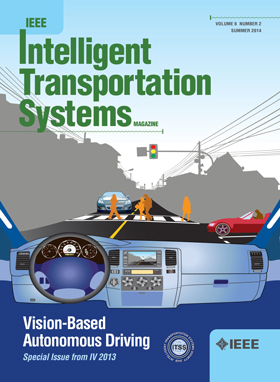ETR: Enhancing Taillight Recognition via Transformer-Based Video Classification
IF 7.9
1区 工程技术
Q1 ENGINEERING, CIVIL
IEEE Transactions on Intelligent Transportation Systems
Pub Date : 2024-12-11
DOI:10.1109/TITS.2024.3509394
引用次数: 0
Abstract
In autonomous driving, efficiently and accurately recognizing taillight states using dashcams is essential for interpreting other vehicles’ intentions. Recent video-based taillight recognition methods outperform earlier image-based approaches. However, they face challenges in efficiently integrating spatiotemporal information and managing high computational costs. In this paper, we introduce ETR, an accurate and efficient Transformer-based video classification model designed to enhance taillight recognition. Specifically, we first design a lightweight backbone to extract temporal and spatial features from videos and generate queries with prior information. Next, we develop a hierarchical progressive Transformer decoder that integrates feature maps from different levels of the backbone to enhance the model’s global information. Finally, we employ a classification head to predict the taillight state of the video. Additionally, we introduce a public dataset, ETR-Taillights, to address the current lack of open datasets for vehicle taillight recognition. The dataset contains 28,799 dashcam video clips, making it the largest public taillight recognition dataset. Experiments show that our method achieves a 91.69% F-measure on the ETR-Taillights dataset, surpassing the latest taillight recognition methods, VIF by 6.94% and CNN-LSTM by 10.82%. Additionally, it achieves an inference speed of 45.06 FPS, being 3.6 times faster than VIF. Furthermore, we conduct real-world road tests to demonstrate our method’s robustness and effectiveness in practical scenarios. Our model and dataset are available at求助全文
约1分钟内获得全文
求助全文
来源期刊

IEEE Transactions on Intelligent Transportation Systems
工程技术-工程:电子与电气
CiteScore
14.80
自引率
12.90%
发文量
1872
审稿时长
7.5 months
期刊介绍:
The theoretical, experimental and operational aspects of electrical and electronics engineering and information technologies as applied to Intelligent Transportation Systems (ITS). Intelligent Transportation Systems are defined as those systems utilizing synergistic technologies and systems engineering concepts to develop and improve transportation systems of all kinds. The scope of this interdisciplinary activity includes the promotion, consolidation and coordination of ITS technical activities among IEEE entities, and providing a focus for cooperative activities, both internally and externally.
 求助内容:
求助内容: 应助结果提醒方式:
应助结果提醒方式:


